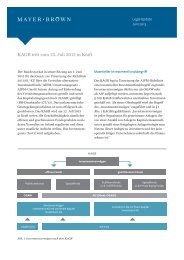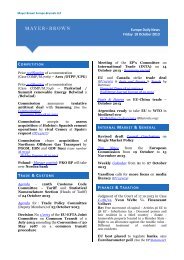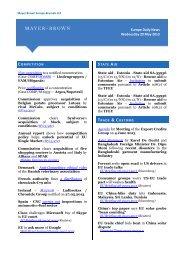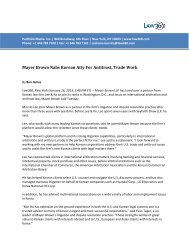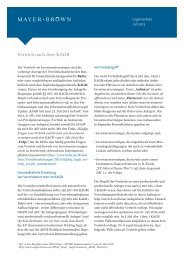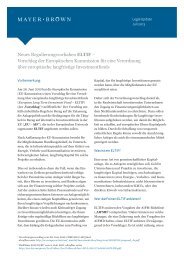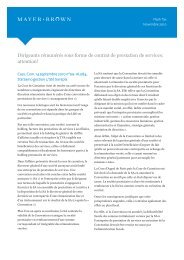- Page 2 and 3:
TABLE OF CONTENTS
- Page 4 and 5:
Competition Committee Meeting, U.S.
- Page 6 and 7:
BASIC ECONOMIC CONCEPTS ARISING IN
- Page 8 and 9:
10:30-11:15 Venturing Outside the U
- Page 10 and 11:
With thanks to our sponsors
- Page 12 and 13:
SPEAKER BIOS
- Page 14 and 15:
Bill advises on EC and multi-jurisd
- Page 16 and 17:
associations. She has counseled com
- Page 18 and 19:
ALICE W. DETWILER is a senior attor
- Page 20 and 21:
property and antitrust. Dr. Gron ha
- Page 22 and 23:
the world. The study was published
- Page 24 and 25:
The acquisition of ADVO, Inc., by V
- Page 26 and 27:
BRITT M. MILLER is a partner in the
- Page 28 and 29:
• Ph.D., Economics, Rice Universi
- Page 30 and 31:
Columbia University (LL.M.) (1999)
- Page 32 and 33:
MEMORANDUM OF UNDERSTANDING ON ANTI
- Page 34 and 35:
II. WORKPLAN 1. The U.S. and Indian
- Page 36 and 37:
United States of America Federal Tr
- Page 38 and 39:
I. Cooperation A. Benefits of Coope
- Page 40 and 41:
To mention a few of our ongoing coo
- Page 42 and 43:
C. China’s Recent Efforts in the
- Page 44 and 45:
programs, secondment of personnel t
- Page 46 and 47:
included recommended practices, cas
- Page 48 and 49:
policies, which are grounded in eco
- Page 50 and 51:
credibility of the competition agen
- Page 52 and 53:
discriminatory (RAND) terms. 11 The
- Page 54 and 55:
enforce, we potentially create two
- Page 56 and 57:
official decision for each of the r
- Page 58 and 59:
costs in these areas. It is also my
- Page 60 and 61:
The framework for cooperation betwe
- Page 62 and 63:
United States of America Federal Tr
- Page 64 and 65:
I. China and the Need for Cooperati
- Page 66 and 67:
egulate and comply with the laws on
- Page 68 and 69:
III. Where China Stands After Five
- Page 70 and 71:
decisions are encouraging, particul
- Page 72 and 73:
competition officials at all five a
- Page 74 and 75:
B. Creating Doctrinal Confusion As
- Page 76 and 77:
high value on intellectual property
- Page 78 and 79:
2013: What to expect on the Europea
- Page 80 and 81:
February 2013 following a reference
- Page 82 and 83:
Servier case, both in the Commissio
- Page 84 and 85:
they represent useful opportunities
- Page 86 and 87:
158 European Competition Law Review
- Page 88 and 89:
160 European Competition Law Review
- Page 90 and 91:
162 European Competition Law Review
- Page 92 and 93:
164 European Competition Law Review
- Page 95 and 96:
JOHN B. MEISEL BEN VAN ROMPUY Natio
- Page 97 and 98:
Editor Julian Maitland-Walker Solic
- Page 99 and 100:
171 CJEU AstraZeneca Judgment: Grop
- Page 101 and 102:
173 court found that the Italian An
- Page 103 and 104:
175 1 An uncertain balancing of int
- Page 105 and 106:
177 refuse disclosure, it has been
- Page 107 and 108:
179 violations of its laws” and t
- Page 109 and 110:
181 The UK Government published its
- Page 111 and 112:
183 Vertical price fixing in the Un
- Page 113 and 114:
185 First, “[t]he Albrecht decisi
- Page 115 and 116:
187 enforcement has promised that p
- Page 117 and 118:
189 UK calls for ban of parallel tr
- Page 119 and 120:
191 In applying these provisions to
- Page 121 and 122:
193 Supply quota system by a non-do
- Page 123 and 124:
195 Member States; withdrawing Lose
- Page 125 and 126:
197 Does the Pfleiderer judgment ma
- Page 127 and 128:
199 of the claim and the amount of
- Page 129 and 130:
201 Such oral statements will be re
- Page 131 and 132:
203 EU law seem difficult for the E
- Page 133 and 134:
205 The ECN has drafted a model len
- Page 135 and 136:
207 The European Commission’s Dec
- Page 137 and 138:
209 1. It needs to be shown that th
- Page 139 and 140:
211 divestment obligations. 33 It i
- Page 141 and 142:
213 restructuring aid donors does n
- Page 143 and 144:
215 of the decision prevented them
- Page 145 and 146:
217 However, it appears that later
- Page 147 and 148:
219 competition-enhancing regulator
- Page 149 and 150:
221 regulation in the United States
- Page 151 and 152:
223 Cunning as a Fox—Dutch Compet
- Page 153 and 154:
225 would be excessive. Regarding t
- Page 155 and 156:
National Reports N-49 National Repo
- Page 157 and 158:
SNCF/Haselsteiner Familien-Privatsi
- Page 159 and 160:
National Reports N-53 discovered du
- Page 161 and 162:
National Reports N-55 Denmark ANTI-
- Page 163 and 164:
National Reports N-57 obstacle for
- Page 165 and 166:
National Reports N-59 The SCPA will
- Page 167 and 168:
National Reports N-61 Roger Guenat
- Page 169 and 170:
National Reports N-63 judiciary as
- Page 171 and 172:
National Reports N-65 US ANTI-COMPE
- Page 173 and 174:
National Reports N-67 SEPs is that
- Page 175 and 176:
free to view Your essential online
- Page 177 and 178:
208 : THE A NTITRUST B ULLETIN: Vol
- Page 179 and 180:
210 : THE A NTITRUST B ULLETIN: Vol
- Page 181 and 182:
212 : THE A NTITRUST B ULLETIN: Vol
- Page 183 and 184:
214 : THE A NTITRUST B ULLETIN: Vol
- Page 185 and 186:
216 : THE A NTITRUST B ULLETIN: Vol
- Page 187 and 188:
218 : THE A NTITRUST B ULLETIN: Vol
- Page 189 and 190:
220 : THE A NTITRUST B ULLETIN: Vol
- Page 191 and 192:
222 : THE A NTITRUST B ULLETIN: Vol
- Page 193 and 194:
224 : THE A NTITRUST B ULLETIN: Vol
- Page 195 and 196:
226 : THE A NTITRUST B ULLETIN: Vol
- Page 197 and 198:
228 : THE A NTITRUST B ULLETIN: Vol
- Page 199 and 200:
230 : THE A NTITRUST B ULLETIN: Vol
- Page 201 and 202:
232 : THE A NTITRUST B ULLETIN: Vol
- Page 203 and 204:
234 : THE A NTITRUST B ULLETIN: Vol
- Page 205 and 206:
236 : THE A NTITRUST B ULLETIN: Vol
- Page 207 and 208:
238 : THE A NTITRUST B ULLETIN: Vol
- Page 209 and 210:
240 : THE A NTITRUST B ULLETIN: Vol
- Page 211 and 212:
242 : THE A NTITRUST B ULLETIN: Vol
- Page 213 and 214:
244 : THE A NTITRUST B ULLETIN: Vol
- Page 215 and 216:
246 : THE A NTITRUST B ULLETIN: Vol
- Page 217 and 218:
248 : THE A NTITRUST B ULLETIN: Vol
- Page 219 and 220:
250 : THE A NTITRUST B ULLETIN: Vol
- Page 221 and 222:
252 : THE A NTITRUST B ULLETIN: Vol
- Page 223 and 224:
254 : THE A NTITRUST B ULLETIN: Vol
- Page 225 and 226:
256 : THE A NTITRUST B ULLETIN: Vol
- Page 228 and 229:
Competition Policy in Brazil Franci
- Page 230 and 231:
Part 1 - Merger Control in Brazil -
- Page 232 and 233:
Substantive Changes What is a “Me
- Page 234 and 235:
Practical Considerations - Pre-merg
- Page 236 and 237:
Overview of the Legislation - “An
- Page 238 and 239:
Largest Brazilian Fines Defendant (
- Page 240 and 241:
Expected Developments - Scenario: (
- Page 242 and 243:
VENTURING OUTSIDE THE US— ANTITRU
- Page 244 and 245:
EN C 11/2 Official Journal of the E
- Page 247:
EN 14.1.2011 Official Journal of th
- Page 252 and 253:
EN C 11/10 Official Journal of the
- Page 256:
EN C 11/14 Official Journal of the
- Page 262:
EN C 11/20 Official Journal of the
- Page 267 and 268:
EN 14.1.2011 Official Journal of th
- Page 279:
EN 14.1.2011 Official Journal of th
- Page 286 and 287:
EN C 11/44 Official Journal of the
- Page 288 and 289:
EN C 11/46 Official Journal of the
- Page 292:
EN C 11/50 Official Journal of the
- Page 300:
EN C 11/58 Official Journal of the
- Page 305:
EN 14.1.2011 Official Journal of th
- Page 309 and 310:
EN 14.1.2011 Official Journal of th
- Page 315 and 316:
EN EN EN
- Page 317 and 318:
COMMISSION NOTICE Guidelines on Ver
- Page 319 and 320:
I. INTRODUCTION 1. Purpose of the G
- Page 321 and 322:
(9) Subject to the conditions set o
- Page 323 and 324:
- does not take responsibility for
- Page 325 and 326:
estrictions of competition, which a
- Page 327 and 328:
purchase, sale and resale, such as
- Page 329 and 330:
estrictions concerning the assignme
- Page 331 and 332:
provides goods and/or services, in
- Page 333 and 334:
favoured-customer clause. The same
- Page 335 and 336:
outing of customers to the manufact
- Page 337 and 338:
dealer's outlet is mobile ("shop on
- Page 339 and 340:
Exemption Regulation), thereby prev
- Page 341 and 342:
agreements enforced by competing su
- Page 343 and 344:
Exemption Regulation becomes applic
- Page 345 and 346:
provider of a business method. For
- Page 347 and 348:
1.1. Negative effects of vertical r
- Page 349 and 350:
(2) To "open up or enter new market
- Page 351 and 352:
instance, economies of scale in dis
- Page 353 and 354:
especially where they establish exc
- Page 355 and 356:
efficiency gains must fully off-set
- Page 357 and 358:
anti-competitive effects can be exp
- Page 359 and 360:
(147) Where the supplier provides t
- Page 361 and 362:
and/or softening of competition. If
- Page 363 and 364:
market, and pre-sale service to ret
- Page 365 and 366:
facilitate collusion, both at the s
- Page 367 and 368:
distribution or do not require the
- Page 369 and 370:
elevant in a market with growing de
- Page 371 and 372:
concerning the products being distr
- Page 373 and 374:
supply obligation. The higher the t
- Page 375 and 376:
cover the expense of those payments
- Page 377 and 378:
this increases the possible foreclo
- Page 379 and 380:
manufacturer with market power to f
- Page 381 and 382:
Antitrust Guidelines for Collaborat
- Page 383 and 384:
AGREEMENTS AMONG COMPETITORS.......
- Page 385 and 386:
ANTITRUST GUIDELINES FOR COLLABORAT
- Page 387 and 388:
collaborations. These Guidelines us
- Page 389 and 390:
The competitive effects from compet
- Page 391 and 392:
collaboration and any individual ag
- Page 393 and 394:
An agreement may be “reasonably n
- Page 395 and 396:
already in operation, 28 then, abse
- Page 397 and 398:
The following sections illustrate c
- Page 399 and 400:
An exercise of market power may inj
- Page 401 and 402:
that is, the technologies or goods
- Page 403 and 404:
Where the nature of the agreement a
- Page 405 and 406:
scope of R&D efforts and investment
- Page 407 and 408:
In the context of research and deve
- Page 409 and 410:
assess the likelihood and magnitude
- Page 411 and 412:
specialized assets or characteristi
- Page 413 and 414:
participants also agree to fix the
- Page 415 and 416:
ut automobile manufacturers would f
- Page 417 and 418:
eported simultaneously to both part
- Page 419 and 420:
it could not adequately assess the
- Page 421 and 422:
Global Guide to Competition Litigat
- Page 423 and 424:
England and Wales Keith Jones, Rich
- Page 425 and 426:
against the infringement finding by
- Page 427 and 428:
Attheraces v BHB 14 confirmed this
- Page 429 and 430:
disclosure in relation to competiti
- Page 431 and 432:
Most claims for damages resulting f
- Page 433 and 434:
that, to avoid discouraging risk ta
- Page 435 and 436:
Contact Information Keith Jones Pho
- Page 437 and 438:
Arbitrating Competition Law Dispute
- Page 439 and 440:
Arbitrating Competition Law Dispute
- Page 441 and 442:
Arbitrating Competition Law Dispute
- Page 446 and 447:
EUROPEAN COMMISSION DG Competition
- Page 448 and 449:
forwarded to DG Competition for pub
- Page 450 and 451:
II. QUANTIFYING THE OVERCHARGE.....
- Page 452 and 453:
• the heads of damages to be comp
- Page 454 and 455:
injured party to be compared with t
- Page 456 and 457:
Raised prices mean that the custome
- Page 458 and 459:
27. Section IV below sets out consi
- Page 460 and 461:
period with the price paid by custo
- Page 462 and 463:
Pre-infringement data could also be
- Page 464 and 465:
(3) Comparison with data from other
- Page 466 and 467:
ules regarding causality, whether a
- Page 468 and 469:
Price 45 40 35 30 25 20 15 10 5 0 I
- Page 470 and 471:
. Examples and illustrations 66. A
- Page 472 and 473:
they sold to bakeries during the ca
- Page 474 and 475:
e.g. through applying specific stat
- Page 476 and 477:
84. Courts in the EU sometimes also
- Page 478 and 479:
model appropriately reflects the co
- Page 480 and 481:
97. It may occur that the observed
- Page 482 and 483:
cases be more appropriate than othe
- Page 484 and 485:
The following figure represents in
- Page 486 and 487:
these studies are set out below in
- Page 488 and 489:
(2) The initial overcharge paid by
- Page 490 and 491:
133. Also, the timing of the cartel
- Page 492 and 493:
141. A further possibility to estim
- Page 494 and 495:
overcharge (for example, where they
- Page 496 and 497:
158. In particular, the comparator-
- Page 498 and 499:
etween the actual profits generated
- Page 500 and 501:
assessing lost profits does not mak
- Page 502 and 503:
lost by the harmed competitor could
- Page 504 and 505:
180 160 Refusal to supply starts 14
- Page 506 and 507:
182. The general approach to quanti
- Page 508 and 509:
have continued producing goods or p
- Page 510 and 511:
to show that, in the absence of the
- Page 512 and 513:
Juzgado Mercantil numero 2 de Barce
- Page 514 and 515:
In case you want to verify which pe
- Page 516 and 517:
International Standards for Experts
- Page 518 and 519:
Snapshots of International Experien
- Page 520 and 521:
Quantification of damages - Most ju
- Page 522:
LESSONS LEARNED FROM COMPLIANCE TO
- Page 548:
will continue to make these decisio
- Page 570 and 571:
Compliance matters What companies c
- Page 572 and 573:
Foreword by Joaquín Almunia Vice-P
- Page 574 and 575:
Contents Foreword..................
- Page 576 and 577:
9 1 Complying with competition rule
- Page 578 and 579:
11 The risk of engaging in anti-com
- Page 580 and 581:
13 3 Compliance with EU competition
- Page 582 and 583:
15 What about Small & Medium Enterp
- Page 584 and 585:
17 In addition, guidance in particu
- Page 586 and 587:
19 cific needs of the undertaking,
- Page 588 and 589:
21 advise on or approve individual
- Page 590:
23 summaries/competition/firms/l261
- Page 593 and 594:
978-92-79-22094-4 KD-32-11-985-EN-C
- Page 595 and 596:
these instruments are essentially p
- Page 597 and 598:
corporate officers, managers, super
- Page 599 and 600:
2) the commitment to appoint one or
- Page 601 and 602:
in itself when making an individual
- Page 603 and 604:
@ Tendances Theodore Banks (dir.) t
- Page 605 and 606:
11. In view of the increasing penal
- Page 607 and 608:
notably to be stressed that even if
- Page 609 and 610:
14. There is also an indicative lis
- Page 611 and 612:
43. An abuse of dominance case was
- Page 613 and 614:
71. There have been approximately 1
- Page 615 and 616:
98. In 2012, the NMa imposed fines
- Page 617 and 618:
D. Complaint for Criminal Sanctions
- Page 619 and 620:
of the more onerous rules on discov
- Page 621 and 622:
g Are competition authorities/agenc
- Page 623 and 624:
the outlined guidelines is availabl
- Page 625 and 626:
202. At present, there is no develo
- Page 627 and 628:
7. Consequences of non compliance f
- Page 629 and 630:
240. In cases where the management
- Page 631 and 632:
g The organization shall take reaso
- Page 633 and 634:
In addition to enhance the good cor
- Page 635 and 636:
299. There would however be scope i
- Page 637 and 638:
327. Originally, the parent company
- Page 639 and 640:
341. As explained above, the sancti
- Page 641 and 642:
359. For example, the Federal Court
- Page 643 and 644:
that even a genuine and bona fide c
- Page 645 and 646:
418. A compliance programme simply
- Page 647 and 648:
eal-estate agents, publishers and s
- Page 649 and 650:
France 465. Adopting a compliance p
- Page 651 and 652:
Best practices for compliance progr
- Page 653 and 654:
France 515. Adopting a compliance p
- Page 655 and 656:
Pakistan 546. No such information i
- Page 657 and 658:
Japan 570. In the event that the co
- Page 659 and 660:
597. Like the IAA - the ISA publish
- Page 661 and 662:
Tab.: Guidance and incentives propo
- Page 663 and 664:
CPI Antitrust Chronicle February
- Page 665 and 666:
CPI Antitrust Chronicle February
- Page 667 and 668:
CPI Antitrust Chronicle February
- Page 669 and 670:
Today’s Topics Translating theor
- Page 671 and 672:
Maximizing Impact with Limited Reso
- Page 673 and 674:
Making It Real In English (or Japa
- Page 675 and 676:
Questions? Thank you for your atten
- Page 677 and 678:
Update on Antitrust Enforcement in
- Page 679 and 680:
Ashok Chawla Chairperson H. C. Gupt
- Page 681 and 682:
Inquiry Process - Non-merger Invest
- Page 683 and 684:
Remedial Powers • Anticompetitive
- Page 685 and 686:
Competition Commission of India Mer
- Page 687 and 688:
Competition Commission of India Mer
- Page 689 and 690:
Competition Commission of India Non
- Page 691 and 692:
Competition Commission of India Bre
- Page 693 and 694:
Competition Commission of India Ant
- Page 695 and 696:
Competition Commission of India Ant
- Page 697 and 698:
Competition Commission of India Abu
- Page 699 and 700:
Competition Commission of India Abu
- Page 701 and 702:
Competition Commission of India Bre
- Page 703 and 704:
Competition Commission of India Bre
- Page 705 and 706:
Highlights of the Proposed Amendmen
- Page 707 and 708:
Highlights of the Amendments to the
- Page 709 and 710:
Some Observations • CCI burdened
- Page 711 and 712:
Some Observations • No “nationa
- Page 713 and 714:
Antitrust, Innovation, and Standard
- Page 715 and 716:
THE BENEFITS AND RISKS OF STANDARDS
- Page 717 and 718:
MEANING OF F/RAND Emerging consensu
- Page 719 and 720:
THE “HOLD UP” PROBLEM: MORE HYP
- Page 721 and 722:
VIEWS FROM THE INDUSTRY “Any unif
- Page 723 and 724:
VIEWS FROM THE AGENCIES “[I]f a p
- Page 725 and 726:
WHITHER STANDARD-SETTING? System of
- Page 727 and 728:
Antitrust Issues in Doing Business
- Page 729 and 730:
The Anti-Monopoly Law (AML) - Effec
- Page 731 and 732:
Enforcement of the AML - 1 Policy A
- Page 733 and 734:
IP in the AML - AML Art. 55 • “
- Page 735 and 736:
IP in the AML - AML Art. 13(5) •
- Page 737 and 738:
Competition in the Patent Law - Pat
- Page 739 and 740:
SAIC Draft Intellectual Property Gu
- Page 741 and 742:
SAIC Draft IP Guidelines - Article
- Page 743 and 744:
SAIC Draft IP Guidelines • Refuse
- Page 745 and 746:
SAIC Draft IP Guidelines - Art. 21
- Page 747 and 748:
SAIC Draft IP Guidelines - Art. 22
- Page 749 and 750:
Proposed Regulation on Standards fo
- Page 751 and 752:
Proposed Regulation for Simple Case
- Page 753 and 754:
Proposed Regulation for Simple Case
- Page 755 and 756:
Draft Rules on Merger Remedies - Ty
- Page 757 and 758:
Draft Rules on Merger Remedies - Ar
- Page 759 and 760:
Recent MOFCOM Merger Decisions © 2
- Page 761 and 762:
Marubeni Acquisition of Gavilon Hol
- Page 763 and 764:
Glencore Acquisition of Xstrata - A
- Page 765 and 766:
Glencore Acquisition of Xstrata •
- Page 767 and 768:
Huawei v. Interdigital - Huawei sue
- Page 769 and 770:
Thank you! Contact information: ste
- Page 771 and 772:
Assessing the Quality of Competitio
- Page 773 and 774:
Assessing the Quality of Competitio
- Page 775 and 776:
Assessing the Quality of Competitio
- Page 777 and 778:
Assessing the Quality of Competitio
- Page 779 and 780:
Assessing the Quality of Competitio
- Page 781 and 782: Assessing the Quality of Competitio
- Page 783 and 784: Assessing the Quality of Competitio
- Page 785 and 786: Assessing the Quality of Competitio
- Page 787 and 788: Assessing the Quality of Competitio
- Page 789 and 790: Assessing the Quality of Competitio
- Page 791 and 792: Assessing the Quality of Competitio
- Page 793 and 794: BASIC ECONOMIC CONCEPTS ARISING IN
- Page 795 and 796: Page 2 of 15 Journal of Competition
- Page 797 and 798: Page 4 of 15 Journal of Competition
- Page 799 and 800: Page 6 of 15 Journal of Competition
- Page 801 and 802: Page 8 of 15 Journal of Competition
- Page 803 and 804: Page 10 of 15 Journal of Competitio
- Page 805 and 806: Page 12 of 15 Journal of Competitio
- Page 807 and 808: Page 14 of 15 Journal of Competitio
- Page 809 and 810: C O V E R S T O R I E S Antitrust,
- Page 811 and 812: C O V E R S T O R I E S proposed tr
- Page 813 and 814: C O V E R S T O R I E S 1 U.S. Dep
- Page 815 and 816: 1 Introduction Empirical competitiv
- Page 817 and 818: metric Cournot model, our framework
- Page 819 and 820: must pay an (explicit or implicit)
- Page 821 and 822: o¤ers a two-step estimation proced
- Page 823 and 824: and All of these are K 0 1 f(pjN =
- Page 825 and 826: accounts for the fact that N t is k
- Page 827 and 828: Let l (p; A; ) denote the joint den
- Page 829 and 830: We now turn to the step 2 results.
- Page 831: anges of 30 to 50 percent for “id
- Page 835 and 836: esources attempting to resolve unce
- Page 837 and 838: References [1] An, Yonghong, Yingya
- Page 839 and 840: [18] Narasimhan, Chakravarthi (1988
- Page 841 and 842: Substituting for in equation (15)
- Page 843 and 844: For each simulated period, t, we ra
- Page 845 and 846: Table 2: Parameter Estimates and Bo
- Page 847 and 848: Table 4: Percentage Change in Post-
- Page 849 and 850: ECONOMIC OVERVIEW Hypotheticals and
- Page 851 and 852: ECONOMIC OVERVIEW ‘But for’ pri
- Page 853 and 854: Horizontal Merger Guidelines U.S.
- Page 855 and 856: 9. Entry...........................
- Page 857 and 858: The unifying theme of these Guideli
- Page 859 and 860: disrupt market conditions with a ne
- Page 861 and 862: merger. However, rival firms may pr
- Page 863 and 864: Defining a market broadly to includ
- Page 865 and 866: satisfying the test, guided by the
- Page 867 and 868: legal or regulatory requirements; a
- Page 869 and 870: Example 12: The merging parties bot
- Page 871 and 872: significant sunk costs, are also co
- Page 873 and 874: 5.3 Market Concentration Market con
- Page 875 and 876: 6. Unilateral Effects The eliminati
- Page 877 and 878: A merger is unlikely to generate su
- Page 879 and 880: complementary capabilities that can
- Page 881 and 882: A market typically is more vulnerab
- Page 883 and 884:
As part of their full assessment of
- Page 885 and 886:
coordinated effects context, increm
- Page 887 and 888:
11. Failure and Exiting Assets Notw
- Page 889 and 890:
influence can lessen competition be
- Page 891 and 892:
The Chicago <stron
- Page 893 and 894:
First Principles - Tying As to tyin
- Page 895 and 896:
First Principles - Evolving Applica
- Page 897 and 898:
Tying Put simply, it is a Seller’
- Page 899 and 900:
Tying - Elements Considered Based o
- Page 901 and 902:
Tying - Element Two That the tying
- Page 903 and 904:
Tying - Element Three Seller must h
- Page 905 and 906:
Tying When those elements are prese
- Page 907 and 908:
Tying - Kodak Kodak - another key t
- Page 909 and 910:
Tying - Kodak (cont.) Ninth Circuit
- Page 911 and 912:
Tying - After Kodak Predicted flood
- Page 913 and 914:
Tying - After Kodak Legacy of Kodak
- Page 915 and 916:
Tying - More Recent Development - I
- Page 917 and 918:
Bundling 27
- Page 919 and 920:
Bundling - Legal Standard Antitrust
- Page 921 and 922:
Bundling - Legal Standard (cont.) T
- Page 923 and 924:
Bundling - “Competitive Products
- Page 925 and 926:
Bundling - After PeaceHealth Pacifi
- Page 927 and 928:
Bundling - Conclusions Bundling wil
- Page 929 and 930:
Exclusive Dealing - Background A re
- Page 931 and 932:
Exclusive Dealing - The Dentsply Ca
- Page 933 and 934:
Exclusive Dealing - The Dentsply Ca
- Page 935 and 936:
Exclusive Dealing - The Intel Case
- Page 937 and 938:
Exclusive Dealing - The Intel Case
- Page 939 and 940:
Exclusive Dealing - The Intel Case
- Page 941 and 942:
Loyalty Discounts 51
- Page 943 and 944:
Loyalty Discounts - Brunswick (cont
- Page 945 and 946:
Loyalty Discounts - Brunswick, Sect
- Page 947 and 948:
Loyalty Discounts - Brunswick, Sect
- Page 949 and 950:
Loyalty Discounts - Brunswick, Sect
- Page 951 and 952:
Loyalty Discounts - Brunswick, Sect
- Page 953 and 954:
Loyalty Discounts - Market Share Di
- Page 955 and 956:
IDENTIFYING AND RESOLVING CONFLICTS
- Page 957 and 958:
Global Conflicts - Introduction •
- Page 959 and 960:
Rule 1.7(a)(1) - Direct Adversity t
- Page 961 and 962:
Rule 1.7(a)(2) - Material Limitatio
- Page 963 and 964:
Corporate Family Issue - When Can a
- Page 965 and 966:
Waivers • Under Rule 1.7(b), a la
- Page 967 and 968:
Rule 1.9 - Duties to Former Clients
- Page 969 and 970:
Rule 1.18 - Duties to Prospective C
- Page 971 and 972:
Conflicts Outside the United States
- Page 973 and 974:
Conflicts in Cross-Border Matters
- Page 975 and 976:
Rule 8.5(b) - Choice Of Law • Rul
- Page 977 and 978:
Cross-Border Issues • 1. Where Pa



